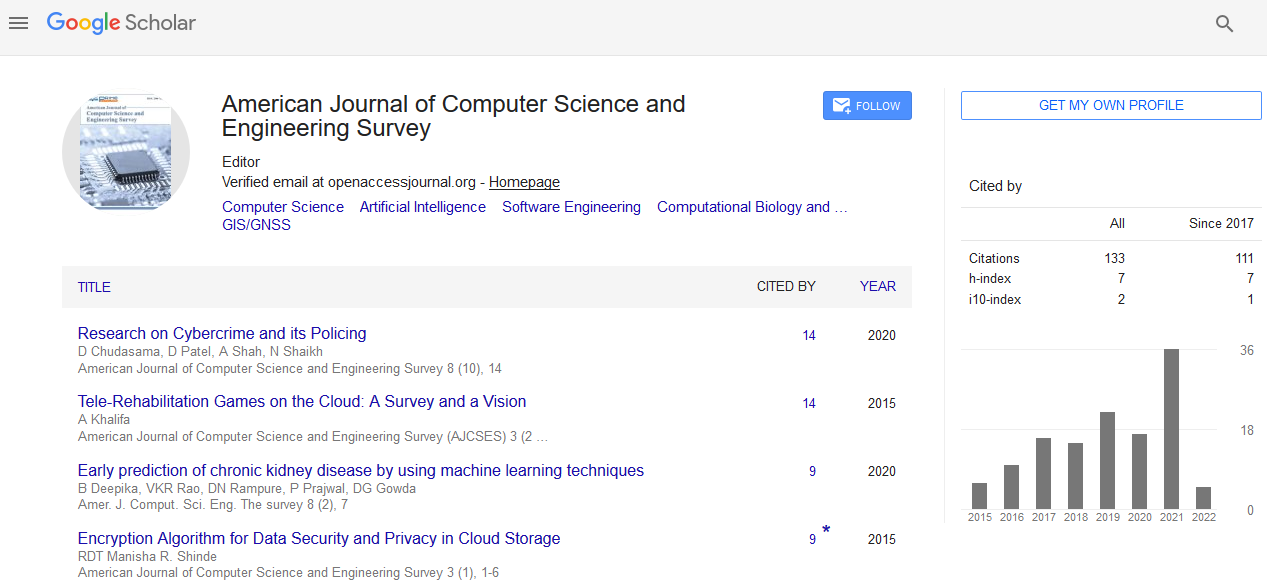Research Article - (2022) Volume 10, Issue 1
Adaptive Technique for Secure Data Transmission to Improving the Cyber Security
P Salman Raju* and
P Venkateswara Rao
Department of Research, Adikavavi Nannaya University, India
*Correspondence:
P Salman Raju, Department of Research, Adikavavi Nannaya University,
India,
Email:
Received: 03-Jan-2022, Manuscript No. IPACSES-21-10461;
Editor assigned: 05-Jan-2022, Pre QC No. IPACSES-21-10461(PQ);
Reviewed: 19-Jan-2022, QC No. IPACSES-21-10461;
Revised: 24-Jan-2022, Manuscript No. IPACSES-21-10461(R);
Published:
31-Jan-2022, DOI: 10.36846/IPAJCSES-10.1.3
Abstract
Internet usage has grown many folds in the last two decades. For many businesses, web applications have become
one of the most significant and critical interfaces. Throughout today’s economic and social life, the use of
web based services (such as e-commerce, online banking, and web based communications, to name a few) has
become a common habit. Countless applications operate worldwide on millions of servers, and their numbers
are steadily increasing. It has become focus of attackers and hackers for the attacks because of the huge growth
of internet usage. It is necessary for all companies to develop and protect their applications in order to maintain
their credibility and keep their products relevant for users. Web applications have brought in new classes of
computer security vulnerabilities, such as SQL injection (SQLIA) and cross site scripting (XSS), which have exceeded
previously prominent vulnerability classes in recent years, such as buffer overflows, in both new vulnerability
reports and exploit reports. The primary purpose of this research is to study the vulnerabilities of SQL Injection
and Cross Site Scripting and to propose an optimistic Security model for secure data transmission. In this work, I
proposed a model with framework for asymmetric and symmetric encryption, which is far more reliable than the
traditional methods of encryption.
Introduction
In the last couple of decades, the practice of the Internet has
developed many folds. Web applications have grown to be one
of the most essential and significant interfaces for several businesses.
The use of web based services including e-commerce,
online banking, and web based emails, has grown to a wide
spread routine in today’s financial and common life. Many applications
are working on millions of servers globally, and their
numbers are continually increasing. Because of massive growth
in internet usage, it grew a target to attackers and hackers for
the attacks. It is simple to target less secure machines. It is apparent,
attacking less secure applications are more comfortable
to target the system. The complexity and extensibility of
Web applications make these applications easy prey by utilizing
software vulnerabilities and weaknesses. SQL infusion attackers are a sort of infusion attacker, in which SQL directions are
infused into information plane contribution to request to impact
the execution of predefined SQL directions [1].
Types of Security
This section will describe the different types of security. For
example, many existing methods such as shifting, data stream
investigation, entry testing, and guarded coding can distinguish
and avert a subset of vulnerabilities leading to SQLIs and XSS.
Session hijacking: Web based applications often use sessions to
upgrade the client amicable experience for their clients. Usage
of different sorts of the session the board does this Session the
executive chips away at the accompanying idea. Session IDs are
recognizable proof tokens for the clients, and are utilized by
the servers to keep up the session information (e.g., factors) [2] (Figure 1).
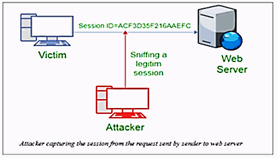
Figure 1: Capturing user session id
Cross site scripting (XSS): For instance, when a purchaser visits
an online store, the articles chosen by him get included in a virtual
shopping basket. He settles the request by heading off to
the store’s checkout page. This ordinarily includes a continuous
Sniffing a real session correspondence between the customer
and the server. The Session ID is one arrangement accessible to
monitor the customer’s truck for each expansion or erasure of
articles from the store. Under specific circumstances, the Session
Fixation weakness empowers the thief to execute a Session
Hijacking attack, by assuming responsibility for the unfortunate
casualty’s session identifier esteem [3].
SQL injection: An SQL injection is a security weakness that occurs
within database application layers. SQL Injection is a web
application database utilisation tool. This is achieved by inserting
the SQL statements as an input string to access the database
unauthorized. For example, a web page on a news site may display
articles related to a specific category, such as Sports, Politics,
etc., depending on the value passed through the URL query
string [4].
Problem statement: Web applications, for example, e-banking
and electronic correspondence highlights, have turned out to
be basic to the day to day lives of numerous individuals with the
rise of the Internet and online utilization. Web applications have
brought new kinds of vulnerabilities to PC protection, for example,
SQL infusion (SQLIA) and Cross webpage scripting (XSS)
that as of late have surpassed already conspicuous helplessness
classes, for example, support floods in the two reports of new
vulnerabilities and reports of adventures. SQL infusion and XSS
are the two occasions of the more extensive class of info approval
based vulnerabilities. At their center, both include one
framework accepting, changing, and developing string esteems,
some of which originate from untrusted and obscure sources,
and showing those qualities to another framework that deciphers them as projects or program sections. These information
approval based vulnerabilities in this way require on a very basic
level new systems to describe and alleviate them [5].
Aim and Objectives
This research also prescribes and recommends defence methods
for security attacks on web applications.
The proposed development has the following subsidiary objectives:
1. Designing characterization and runtime research of SQL
injections on web applications and executing Cross Site
Scripting and XPath injections. Also, this research explains
about Static analysis for SQL injections.
2. This research also describes, Static Analysis for identifying
Cross site Scripting (XSS vulnerabilities), empirical assessments
of the XSS vulnerability attacks. This paper additionally
describes implementations of secure algorithms, showing
them to be effective for their respective settings [6].
Literature Review
The growth of technology equally increases vulnerability. Subsequently,
the more researches center around innovation, the
more importance laid on the detection and prevention of related
vulnerabilities. There is a rich amount of literature in this
field.
Review of existing studies: SQL injection and cross site scripting
(XSS) has emerged as the recent vulnerability in the web world.
In such a situation, it is important to give extra protection systems
to secure the critical data that is recovered by SQL queries
developed cautiously by programmers [7].
SQL injection attacks: SQL injection attacks (SQLIAs) Structured
query language (SQL) is a deciphered language that is used in
web applications powered by a database that generates SQL articulations
that fuse the client’s knowledge or content.
Cross site scripting attacks: Cross website scripting (XSS) is another
web application procedure of attacking that includes reverberating
attacker provided code into a customer’s program
by means of site pages seen by the objective clients.
Comparison of existing studies: Many research studies have
been directed in addressing the issues identified with SQLI and
XSS since the time they were discovered. Since it is very difficult
for eliminating all the vulnerabilities of XSS and SQLI prior to
being deployed in an application, penetration testing and other
powerful investigation systems ought to be utilized after deploying
to persistently test the application [8] (Table 1).
Table 1: Comparison of some of the studies discussed [12].
| Author |
Objective |
Techniques developed |
SQLI or XSS |
Results obtained |
Research gap |
| Ciampa et al. (pp. 43-49) |
Identifying vulnerabilities of SQLI in web applications. |
Heuristic-based approach and a tool-named V1p3R for penetration testing of the web applications. |
SQLI |
The developed tool reduced the cost by restricting the consumption of resources and interaction of the testers. |
Improvement in tool heuristics, specifically concerning the correct interpretation of web pages that are a result of attacks. |
| Sharma et al. (pp. 343-351) |
Prevention of SQLI and reflected XSS attacks on the PHP website. |
Modification of the existing model by employing the the logic for averting the different types of SQLIA, integration of a separate module for averting reflected XSS attacks. |
Both |
Results showed that the developed approach was 100% efficient in averting SQLI and reflected XSS attacks. |
Additionally, keeping in perspective on the adequacy of this model in averting specific kinds of Reflected XSS attacks, the model could be additionally extended to forestall different sorts of XSS attacks. |
| Ghafarian (pp. 833-838) |
Reducing the SQLIA vulnerability in web applications. |
A combination of static and dynamic approach is developed. |
SQLIAIn |
In comparison with the existing developed technique is more effective since it had the ability to handle queries of any kind. Also, the algorithm is independent of the platform. |
The proposed method is in its theoretical stage and practical implementation is yet to be carried out. |
| Shar et al. (pp.1767-1780) |
Provide an alternative solution for the current taint analyzers by introducing attributes of static code that could be utilized in predicting the particular statements of the program, instead of software components, that might be vulnerable to XSS or SQLI. |
Development of vulnerability models of prediction from the historical data whichreflects developed static attributes along with vulnerability data that is known for predicting XSS and SQLI vulnerabilities. |
Both |
Recall of 93% recall, a false alarm of 11% to predict the vulnerabilities of SQLI, Recall of 789% recall, a false alarm of 6% to predict the vulnerabilities of XSS. |
The developed predictors were application-specific. |
| Gupta et al. (pp.1595-1602) |
Investigate the response of HTTP for extraction of script content. |
Defensive XSS framework for the cloud platforms detecting the transfer of reflected XSS worms in the applications of web employed in the virtual machines present in the cloud. |
XSS |
The exploratory outcomes uncover that the proposed system distinguishes the XSS worms with a low pace of false negatives and positives. |
Integration of the capabilities of the developed model on the different cloud computing platforms. |
| Parvez et al. (pp. 186-191) |
Evaluating the black-box web application scanners efficiency for detecting stored vulnerabilities of SQLI and XSS. |
A custom test-bed was developed for evaluating the capability of the scanner to detect stored vulnerabilities of SQLI and XSS. |
Both |
The detection rate of the scanners for detecting XSS attacks had improved while that for SQLIA requires improvement. |
The selection of correct vectors for detecting and exploiting the stored vulnerabilities of SQLI and XSS is a significant challenge for the black-box scanners. |
| Gupta et al. (pp. 199-203) |
Applying IDS in detecting the XSS attacks. |
Rules for XSS attack detection utilizing IDS. monitored the outgoing and incoming packets for further matching with the rules of the database. |
XSS |
The system proposed selected the attacks of XSS precisely. |
The detection speed requires enhancement, this can be accomplished by the use of other keywords along with PCRE. |
| Akbar et al. (pp. 286-292) |
Development of OWASP ModSecurity Core Rule Set that can aid the administrator in securing the servers of the web. |
OWASP ModSecurityWeb Application Firewall. |
Both |
The developed method obtained a 100% detection rate for both XSS and SQLI attacks. |
Extension of the set of core rules of OWASP ModSecurity for securing certain XSS attacks that Was not provided by OWASP ModSecurity. |
Methodology
Collection of Database and Sql Injection and Xss
SQL injection attacks: An SQL injection is a type of attack in
which the attackers insert Structured Query Language (SQL)
code into the inputs of the web in order to access (or modify)
data. Several tools are available to detect and prevent these vulnerabilities.
Classification of SQL injection attacks: An SQL injection is a
type of attack in which the attackers insert Structured Query
Language (SQL) code into the inputs of the web in order to access
(or modify) data. Several tools are available to detect and
prevent these vulnerabilities.
SQL injection is a model which exploits a web application’s database.
The information provided is description of attacks with
SQL injection [9].
1. Order wise: It composes of first order injection attack and
second order injection attack. The common data types such
as DATE and NUMBER which is considered as exploitable.
2. Classical SQL injection attack: This attack combines with
two SQL queries and then the attacking process is initiated. It does not allow accessing the additional data in a certain
table.
3. Blind SQL injection attack: It is different from that of the
original. This helps the threat agents to create the database
by analysing the expressions. It is further classified as:
(a) Standard Blind. It embeds operator and separator <”.”>
With application of <union>. (b) Double Blind SQL injection:
It returns error messages from queries that removed
a web application from the returned list.
4. Attacks against database: (a) SQL manipulation: It is being
categorized as a tautology, Inference, basic union queries
and piggybacked queries. (b) Code Injection: This is easily
applied to the Microsoft SQL applications. (c) Functional
call injection: These function calls can be used to make
operating system calls or manipulate data in the database.
5. Cross site scripting attacks: Cross Site Scripting is one of
the injection attacks that permit the hacker to execute the
scripts in the user’s browser. In some cases, the user becomes
a victim when they visited the web pages without
prior knowledge about it (or) not.
The following script is widely used for detecting XSS attacks (Figure 2).

Figure 2: Script is widely used for detecting XSS attacks.
Identity Based Encryption (IBE): The identity attributes of the
users were used for encryption and decryption purposes. The
identity attributes are the email address (or) phone numbers
that were deployed instead of digital certificates [10]. No prerequisites
are required for the part of the recipient to receive
an encrypted message [11]. No need for maintaining the public
key infrastructure [12]. Inherent key escrow issue is tackled in
the IBC environment [13].
i. Set up: It is executed by the key authority.
ii. Private key generation: It is executed by the key authority
which takes the inputs (mpk, msk), identity id and state
st.
iii. Decryption key generation: It is executed by the receiver.
iv. Encryption: This algorithm is run by the Encryption algorithm
of the sender.
v. Decryption: It is executed by the receiver.
Advanced Encryption Standard (AES)
It is helpful for defining protection algorithms for unclassified
data. AES is significantly used in the private sector [14].
The minimum requirement of AES is:
A. The algorithm must be symmetric in the key management
system.
B. It must be a block cipher.
C. It should be capable of key block combination with sizes of
123-128, 192-128, 256-128 bits.
The evaluation criteria for AES are
a. Security: It aims to enhance the security weakness of
DES.
b. Cost: The reasons behind these criteria are to measure
and minimize the costs of licensing requirements, computational
efficiency and the memory requirements.
c. Algorithm and implementation characteristics: It includes
criteria such as flexibility, hardware, and software suitability
and simplicity.
The effectiveness of the AES algorithm is computed as:
Effectiveness=f (Efficiency, Security)
Efficiency=f (performance, resource utilization)
Security=f (security margin, ancestry, and simplicity).
Proposed Frame Work
Dragonfly optimization: Inspired by the swarming behaviour
of the dragonfly, a novel bio-inspired optimization algorithm,
named, dragonfly optimization. It belongs to the class of adaptive
technique and the unconstrained test function using localization
models. It holds quality features of both static and
dynamic swarming process that covers vast area towards targeted
destination (or) optimization [15]. Dragonfly optimization
is proposed by Seyedali Mirjalili, admired by the swarming
behaviour of the dragonflies. Actually, it flies in a different direction
in small groups in search of food. In technical terms, optimization
in search of food is known as the exploration phase.
The followings are the pictorial representation of the dragonfly
algorithms [16] (Figure 3-9).
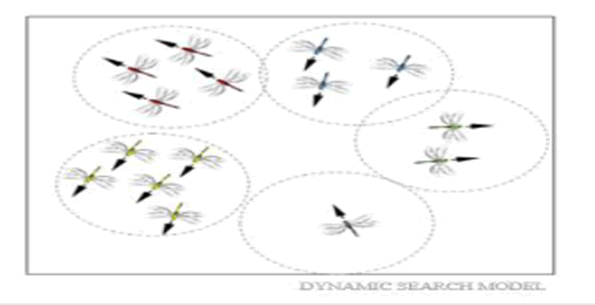
Figure 3: Dynamic search model
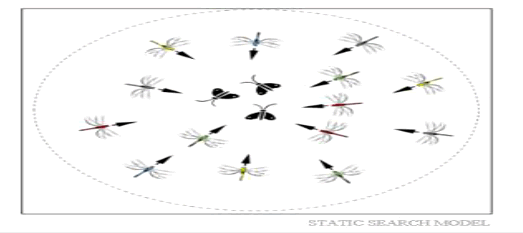
Figure 4: Static Search model
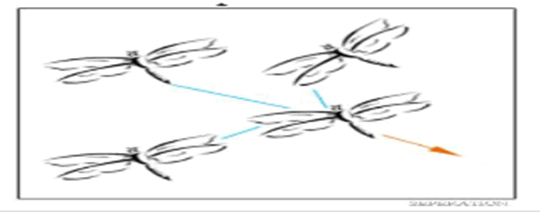
Figure 5: Separation process

Figure 6: Alignment process
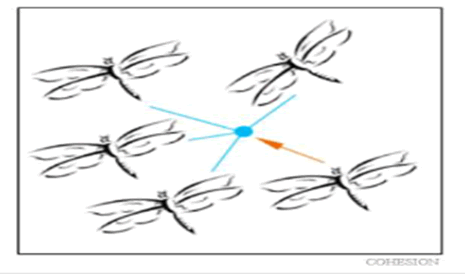
Figure 7: Cohesion process
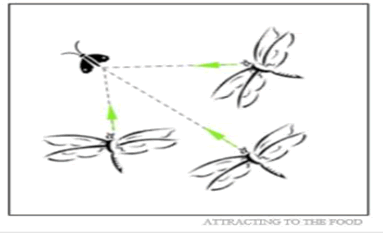
Figure 8: Attracting to the food
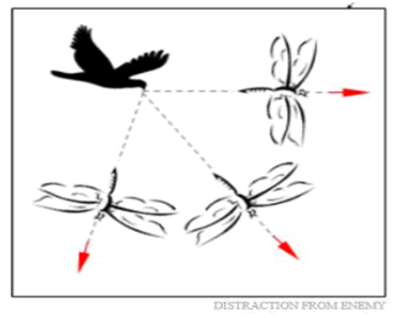
Figure 9: Distraction from enemy
Thus, each portion of the dragonfly algorithm is formulated as:
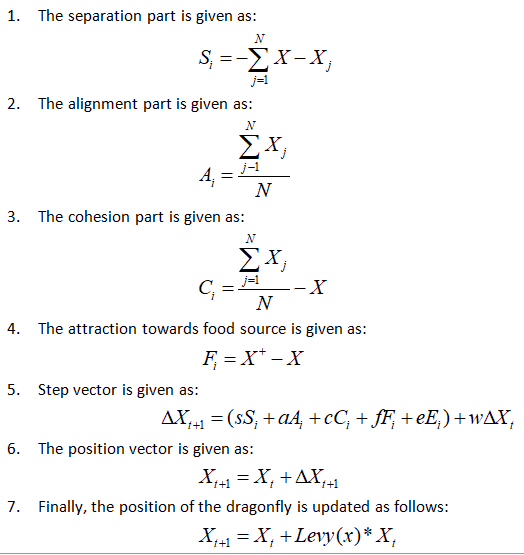
Where,
X represents the location of the current individuals.
N represents the neighbouring individuals
X+ represents the position of food source
X- represents the position of the enemy s represents the weight
of the separation process
a represents the weight of the alignment process
c represents the weight of the cohesion process
f denotes the weight of food source
e denotes the weight of enemy
w denotes inertia weight
t represents iteration counter
d represents the dimension of position vectors that levy calculated
flight steps.
The followings are the pseudo code of the proposed algorithms
to detect and prevent SQL injection attacks and cross-site
scripting.
A. Pseudo code for AES (Figure 10)
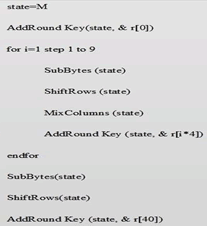
Figure 10: Pseudo code for AES.
B. Pseudo code for IBE (Figure 11)
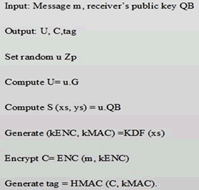
Figure 11: Pseudo code for IBE.
C. Pseudo code for DA-GA Algorithm (Figure 12)
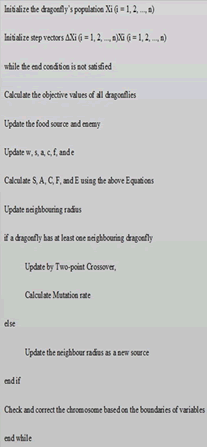
Figure 12: Pseudo code for DA-GA Algorithm.
Results and Discussion
Time and Speed analysis of the algorithm determines the characteristics
of the process via time required for encryption and
decryption.
Encryption Time
The time required to converts the plaintext into ciphertext is
said to an encryption time. The encryption time based on the message block size and key size, and represented in milliseconds.
It has direct impacts on the performance of the encryption
algorithm. Every cryptographic algorithm required minimum
encryption time, in order to make the encryption scheme
responsive and fast.
Decryption Time
The time required to recover the plaintext from cipher text is
said to decryption time. For the purpose of cryptographic algorithms
fast and responsive, it is desirable that the decryption
timeless similar to the encryption time and it is also measured
in milliseconds.
The below mentioned graph shows the effective performance
of the algorithm
The comparison graph showed that the test data showed higher
number of counts in comparison to the sample data as well
as SQL database.
Conclusion
This research appears to include approval based vulnerabilities
that exist with regard to meta-programming in the specific circumstances
of web applications, or even more so for the most
part. In light of ideas from programming dialects and compilers,
this paper gives the primary principled portrayal for such
vulnerabilities, with formal definitions specifically for SQL injection
and XSS. In addition, increasing on this portrayal, the
exploration contributes a reasonable algorithm for runtime security,
static investigation, and test based investigation of web
applications to identify vulnerabilities in application code and
prevent misuse of attackers.
The vulnerabilities are normally present in web applications. It
appears to be misused by SQL injection attacks to collect the
gain from the application’s involvement. Careful coding has
been recommended as an answer to mitigating the SQLIAs.
Since Cross Site Scripting (CSS) and SQL Injections (SQLI) are the
extremely risk filled that happens regularly in the present web
attacks, we tried to focus more on them and attempted to clarify
with point by point models. Further we suggested a framework
to differentiate between SQLIA and XSS based on AES and
IBE encryption. Additionally, it is streamlined depending 130
on the neural relapse systems. What’s more, we executed the
SQLIA and XSS model location program. Our pages of structure
inspections that can trigger XSS and gain powerlessness follow
during the position procedure. In line with these, our approach
will naturally produce attack vectors, which is very important
for engineers and analysers to identify as well, to overcome the
vulnerabilities in the code.
REFERENCES
- Benjamin L, Úlfar E (2007) Using web application construction frameworks to protect against code injection attacks. Proceedings of the 2007 workshop on Programming languages and analysis for security. ACM.
[CrossRef] [GoogleScholar]
- Desmet L (2008) Provable protection against web application vulnerabilities related to session data dependencies. IEEE transactions on software engineering. 34(1):50-64
[CrossRef] [GoogleScholar] [ResearchGate]
- Kunal G, Rajni RS, and Manish D (2017) Cross site scripting (XSS) attack detection using intrusion detection system. 2007 IEEE
[CrossRef] [GoogleScholar]
- Ahmad G (2017) A hybrid method for detection and prevention of SQL injection attacks.2017 Computing Conference. IEEE
[CrossRef][GoogleScholar]
- Guardia Vieira M, Madeira H, Fonseca J (2007) Web Vulnerability Scanning Tools for SQL Injection and XSS Attacks Dependable Computing. CISUC - Polytechnic Inst. of Guardia,Testing and Comparing, 2007. PRDC 2007.13th Pacific Rim International Symposium on Date of Conference: 17-19 Dec. 2007.
[GoogleScholar] [ResearchGate]
- Umasankari P, Uma E, Kannan A (2013) Dynamic Removal of Cross Site Scripting Vulnerabilities in Web Application. International Journal of Advanced Computational Engineering and Networking. Volume 1(4).
[GoogleScholar] [CrossRef]
- Subhranil S, Sapna S, Ritu K (2016) Study on sql injection attacks: Mode detection and prevention. International Journal of Engineering Applied Sciences and Technology, Indexed in Google Scholar, ISI etc., Impact Factor: 1.494 1.8 (2016): 23-29.
[CrossRef][GoogleScholar]
- Farmer, Randall F, Chip M, Douglas C (1994) From Habitat to global cyberspace. Proceedings of COMPCON'94. IEEE, 1994
[GoogleScholar] [ResearchGate]
- Jivesh G, Jivika G (2007) Ramifications of cyber-crime and suggestive preventive measures. IEEE International Conference on Electro/Information Technology
[GoogleScholar][ResearchGate]
- Hydara I, Sultan ABM, Zulzalil H, Admodisastro N (2014) Current state of research on cross-site scripting (xss) c a systematic literature review. Information & Software Technology 58 (2014) 170–186
[CrossRef] [GoogleScholar] [ResearchGate]
- Saleh A, Mohamed A, Hemeida A, Ibrahim A (2018) Comparison of different optimization techniques for optimal allocation of multiple distribution generation. Proceedings of the 2018 International Conference on Innovative Trends in Computer Engineering (ITCE), Aswan, Egypt, February 2018
[GoogleScholar] [ResearchGate]
- Parmar A, Darji P (2018) Comparative analysis of optimum capacity allocation and pricing in power market by different optimization algorithms. Advances in Intelligent Systems and Computing. pp. 311–326. Springer, Singapore
[CrossRef] [GoogleScholar] [ResearchGate]
- Halfond, William G, Jeremy V, Alessandro O (2006) A classification of SQL-injection attacks and Countermeasures .Proceedings of the IEEE International Symposium on Secure Software Engineering. Vol.IEEE
[GoogleScholar] [ResearchGate]
- Apon D, Fan X, Liu FH (2016) Compact identity-based encryption from lwe. IACR Cryptology ePrint Archive
[CrossRef][GoogleScholar]
- Ritu G, Ravi B (2014) Protection against SQL Injection Attack on Web Applications Using AES and Stored Procedure.IJARCSSE. 4(5):2014
[GoogleScholar] [ResearchGate]
- Diab AAZ, Rezk H (2018) Optimal sizing and placement of capacitors in radial distribution systems based on grey wolf, dragonfly and moth-flame optimization algorithms. Ir J Sci Tech Trans Elec Engg. 43(1).pp. 77–96
[CrossRef][ResearchGate][GoogleScholar]
Copyright: This is an open access article distributed under the terms of the Creative Commons Attribution License, which permits unrestricted use, distribution, and reproduction in any medium, provided the original work is properly cited.














